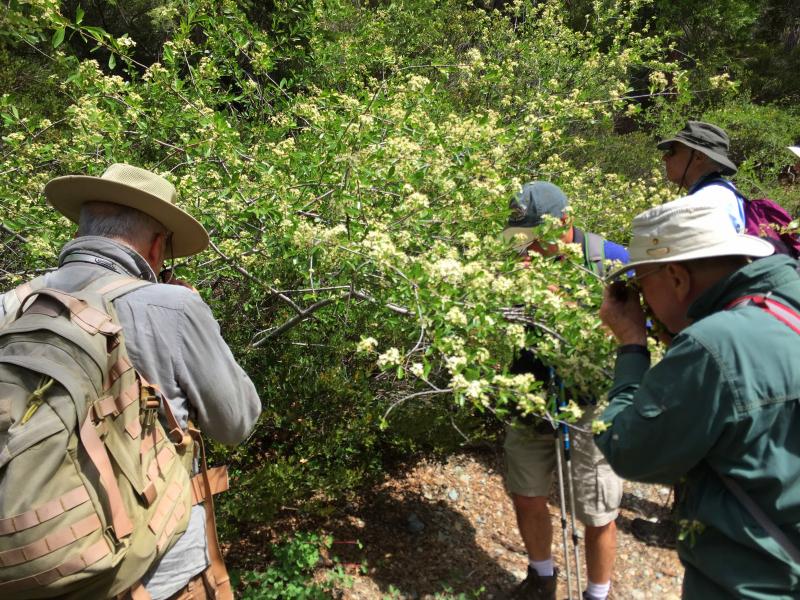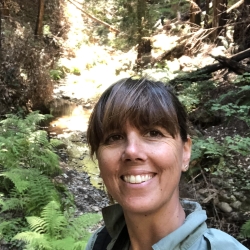Trees & Shrubs of Northern Sierra Nevada
Dates: June 13-15, 2025
Instructor: Tanya Baxter
Fee: $300.00 + meals and accommodations fees
Term: Summer 2025
Workshop Description
Have you ever wanted to become familiar with the plant life of the Sierra Nevada forest but didn’t know where to begin? This course will provide a less intimidating introduction to help you define the iconic beauty of Sierra trees and shrubs. Through this course you’ll learn to recognize which conifers, oaks, and shrubs grow where. You'll understand the ecology of how each species plays a role in the forest. Both common and scientific names will be used. More importantly, students will come away with knowing how to recognize growth and habitat patterns and how to apply identification to further inquiry into the Sierran plant life. Using our outdoor classroom, we will focus on hikes to capture the spectrum of trees and shrubs across their elevational habitat as high as 8,500 ft.


Instructor Bio
Tanya Baxter
Tanya is a botanist and ecologist. A love for the Sierra, she has surveyed 12,000 acres of post-fire flora for Yosemite National Park and recently surveyed rare serpentine pine forests of Plumas County. Tanya served for the National Park Service for 10 years, much of it as a project manager in restoration ecology. She holds a masters in science from San Francisco State University in Ecology and Evolutionary Biology. A scientist, naturalist and storyteller, she evokes a sense of awe and interconnectedness of botany into the lives of her participants. You may contact Tanya @ tanyabaxter10@gmail.com or learn more at her website.
Workshop Details
Course Schedule
We will start with a lecture in the Friday evening. There will be 2 full day hikes to the region and the stunning contrast of the high elevation as high as 8,500 ft. Hikes of 1500ft elevation max at a plant hike pace. (Note hiking poles are helpful along with sturdy footwear and layers for changing sierra temperatures). Mornings start at 8am/8:30am after breakfast. We review major trees and shrubs in the morning before taking on long hikes. Lunch will be on off campus both days for all day field trips. There will be free time prior to dinner to explore the adjacent North Yuba River. Due to snow melt trail destinations of field trips are subject to change. Course ends Sunday mid afternoon.
Workshop Supplies List
CLOTHING: Bring good walking shoes. Most days will be gentle with regard to walking, but we may hike to the top of the Sierra Buttes. Plan for all kinds of weather. Days should be warm, but evenings can be cool. Bring short pants for warm hikes, and/or long pants for mosquito protection. It frequently rains in the Sierra in late June. Most of all, bring a hat and sunscreen for protection. Old sneakers, rubber boots, or hip-waders may come in handy for marsh prowling.
TEXT: Field Guide to the Sierra Nevada by John Muir Laws (recommended)
Jepson Manual of California Plants, 2nd edition (optional)
MISC: field notebook, 10x hand lens - (best if attached to a loop), 10 cm ruler
Lodging and Camping Supplies
Camping gear if you are staying on campus:
- tent and sleeping pad (unless you are staying in our tent with a cot provided)
- warm sleeping bag
- pillow, toiletries, and towel
- flashlight and lantern
- alarm clock
Field gear for everyone:
- day pack
- sunscreen
- insect repellant
- water bottles
- plastic containers for packed lunches
- sense of humor
You might also want to bring:
- camera
- binoculars
- hand lens
- camp chair
Clothing:
The weather in the Sierra Nevada can vary greatly, even in a single day. Be prepared for chilly temperatures at night, even below freezing early in the summer. Rain is a possibility any time, whether forecast or not. Variable weather clothing that can be layered is best: long pants and a long-sleeved shirt, warm sweater and jacket, t-shirt and shorts or skirt, sturdy shoes or hiking boots, sun hat, rain gear, and a warm hat or gloves for cold weather and/or night activities. And, if you come later in the season, bring your swimsuit for afternoon dips in the lakes!